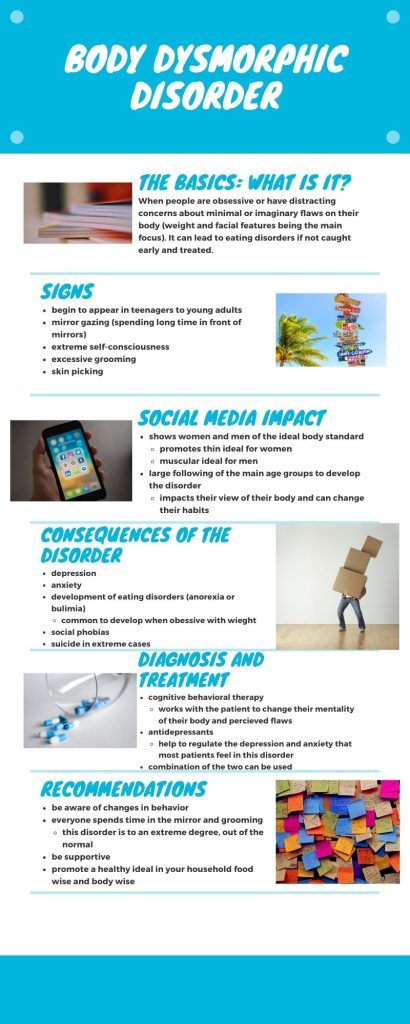9
Sydney Worrrall
What is Body Dysmorphic Disorder?
Body Dysmorphic Disorder (BDD) is when a person has an obsessive or distracting concern with their appearance, such as slight flaws (normally negative) that only they notice. (Singh & Veale, 2019). These flaws can be related to their weight, facial features, or even imagined faults, and people around the sufferer tend to never notice the flaws that cause so much distress. BDD is common around the world with near equal occurrence in men and women, women being slightly higher. Women tend to be more influenced by the media and societal standards of beauty than men are. Normally, BDD presents in teenagers and young adults and is influenced by current social and media practices (Singh & Veale, 2019). Women and men experience different forms of the disorder, with women having more of a thin ideal and men suffering more from muscle dysmorphia (MD), an obsession with a highly muscular body (Waldorf et al., 2019). Young adults, specifically college-aged women, are highly susceptible to social influence and develop many of their ideals and self-belief images during this season of stress and life changes (Aparicio-Martinez et al., 2019).
Signs and Symptoms
Often times, BDD goes undiagnosed because parents and friends see the behavior as normal for the age. There is a fine line between BDD and normal concerns with body image. BDD is the extreme case, such as obsessing over flaws for hours. Common signs include extreme self-consciousness, repetitive behaviors (excessive grooming or skin picking), both of which are hard to hide (Singh & Veale, 2019). One of the most telling signs is mirror gazing or spending long periods of time in front of the mirror focusing on the possible flaw.

The longer the gazing in the mirror continues, the less attractive or more negative one feels about their appearance (Möllmann et al., 2019). They constantly see the flaw and consider it to be more severe than reality. Men have a similar gaze behavior by looking at muscular bodies and feeling more negative about their own when they are not the same (Waldorf et al., 2019). Other common signs are excessive grooming or skin picking behaviors. In these behaviors, the person is trying to hide the flaw or get rid of it entirely. It may be common to spend hours getting ready or just checking your hair or face every 15-30 minutes and re-fixing your appearance. Another sign of excessive grooming is extra makeup that overly covers the flaw.
Impact of Society and Social Media
Society has a large impact on BDD with many of its sufferers focusing on society’s attitudes and beliefs about beauty and its norms (Ahmadpanah et al., 2019). These ideals are highly seen in social media, such as Instagram and Facebook. Young adults also feel the pressure to fit into society and find friends and partners, which is influenced by what society defines as beauty. Social media also increases the thin-ideal, in addition to other beauty standards. One study showed that about 90% of young people identified themselves as active users on social media sites (Aparicio-Martinez et al., 2019). This is a large audience that is influenced by role models and advertisements that society celebrates as beautiful or the standard of beauty. Another study found that 80% of young people are influenced by the thin-ideal and fit standards of these sites (Barajas-Iglesias et al., 2018). The thin-ideal leads to disordered eating, body dissatisfaction, and can impact body image standards around the world. It has also led to problems in exercise addiction, which creates higher risks for developing BDD (Corazza et al, 2019). This concern for physical appearance and fitness levels create an atmosphere for BDD to grow as individuals become more and more obsessive about their body image.
Diagnosis and Treatment
BDD has been linked as a cause of other disorders, including major depressive disorder, social phobias, obsessive-compulsive disorders, substance misuse disorders, and some eating disorders (Singh & Veale, 2019). The linked disorders are easier to diagnose, which is one of the reasons BDD is commonly overlooked. Other consequences of BDD include distress, avoidance of social and close relationships, and in extreme cases, suicide (Sighn & Veale, 2019). BDD has a high rate of suicide amongst sufferers when the distress and obsession become too much to bear. The sufferers often feel shame, disgust, anxiety, or sadness when they cannot fix their imagined flaws.
The treatment options for BDD are cognitive behavioral therapy (CBT) and serotonin reuptake inhibitor (SRI) medication, which are commonly used to treat depressive disorders. CBT is used to help patients develop a new understanding of their appearance and disregard the negative ones they have come to know and criticize (Singh & Veale, 2019). It can take many counseling sessions for a patient to develop this and continue to keep this new image when they look at themselves. At the same time, patients can revert back to the disorder when they are not supported in their new ideal by those close to them, also leading to future difficulty.
For more information about treatment options, visit: Mayo Clinic Website
Summary
BDD affects many people every year and can be hard to diagnose. Remember to be patient through the process and pay attention to changes in behaviors in children. Be supportive through the treatment and remember to promote healthy ideals in the household. Here is an infographic to use to remember the keys to BDD.

Review Questions
a. promotes the thin ideal
d. minimal impact
References
Ahmadpanah, M., Arji, M., Arji, J., Haghighi, M., Jahangard, L., Bahmani, S., & Brand, S. (2019). Sociocultural attitudes towards appearance, self-esteem, and symptoms of body-dysmorphic disorders among young adults. International Journal of Environmental Research and Public Health, 16(21), 4236. doi: 10.3390/ijerph16214236
Aparicio-Martinez, P., Perea-Moreno, A., Martinez-Jimenes, M., Redel-Macías, M., Pagliari, C., & Vaquero-Abellan, M. (2019). Social media, thin-ideal, body dissatisfaction and disordered eating attitudes: an exploratory analysis. International Journal of Environmental Research and Public Health, 16(21). doi: 10.3390/ijerph16214177.
Barajas-Iglesias, B., Jáuregui-Lobera, I., Laporta-Herrero, I., & Santed-Germán, MÁ. (2018). The influence of the aesthetic body shape model on adolescents with eating disorders. Nutricion Hospitalaría, 35(5), 1131-1137. doi: 10.20960/nh.1826.
Corazza, O., Simonato, P., Demetrovics, Z., Mooney, R., Ven, K. V. D., Roman-Urrestarazu, A., Rácmolnár, L., De Luca, I., Cinosi, E., Santacroce, R., Marini, M., Wellsted, D., Sullivan, K., Bersani, G., Martinotti, G. (2019). The emergence of exercise addiction, body dysmorphic disorder, and other image-related psychopathological correlates in fitness settings: A cross-sectional study. PLos One, 14(4). doi: 10.1371/journal.pone.0213060
Möllmann, A., Hunger, A., Dusend, C., van den Hout, M., & Buhlmann, U. (2019). Gazing at facial features increases dissociation and decreases attractiveness ratings in non-clinical females- A potential explanation for a common ritual in body dysmorphic disorder. PLos One, 14(7), pp. e0219791. doi: 10.1371/journal.pone.0219791.
Singh, A & Veale, D. (2019). Understanding and treating body dysmorphic disorder. Indian Journal of Psychiatry, 61(1), 131-135. doi:10.4103/psychiatry.IndianJPsychiatry_528_18
Waldorf, M., Vocks, S., Düsing, R., Bauer, A., & Cordes, M. (2019). Body-oriented gaze behaviors in men with muscle dysmorphia diagnoses. Journal of Abnormal Psychology, 128(2), 140-150. doi: 10.1037/abn0000403.
pathological preoccupation with an imagined or slight physical defect of one's body to the point of causing significant stress or behavioral impairment in several areas (as work and personal relationships)
pathological preoccupation with the perceived smallness or weakness of one's body and musculature often leading to excessive exercise (such as bodybuilding), steroid abuse, or eating disorders
psychotherapy that combines cognitive therapy with behavior therapy by identifying faulty or maladaptive patterns of thinking, emotional response, or behavior and substituting them with desirable patterns of thinking, emotional response, or behavior
any of a class of antidepressants (such as fluoxetine) that inhibit the inactivation of serotonin by blocking its reuptake by presynaptic neuron endings
